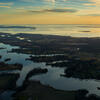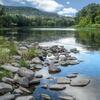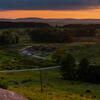The National Park Service cares for special places saved by the American people so that all may experience our heritage. Did you know there are dozens of National Park Service sites right in Pennsylvania, New Jersey, New York and Delaware? An adventure into history or natural wonders (or both) is just a short distance away! Temple University also provides training for individuals interested in becoming National Park Service law enforcement rangers!

The National Park Service (NPS) is an agency of the federal government of the United States that manages all national parks, many national monuments, and other conservation and historical properties with various title designations. The United States Congress created the agency on August 25, 1916. A treasure trove of National Park Service videos are available here.
The NPS is an operating unit of the United States Department of the Interior. The agency is charged with a dual role of preserving the ecological and historical integrity of the places entrusted to its management while also making them available and accessible for public use and enjoyment.
A Brief History of the National Park Service
By the Act of March 1, 1872, Congress established Yellowstone National Park in the Territories of Montana and Wyoming "as a public park or pleasuring-ground for the benefit and enjoyment of the people" and placed it "under exclusive control of the Secretary of the Interior." The founding of Yellowstone National Park began a worldwide national park movement. Today more than 100 nations contain some 1,200 national parks or equivalent preserves. Learn more about the History of the National Park Service.
Temple University and the National Park Service: Partnering to Protect Our National Treasures
ProRanger Philadelphia is an academic and technical skills training and internship program that is cooperatively administered by the National Park Service and Temple University. The program was established to train and expose students to the career field of a law enforcement park ranger. In this video, Daniel Boyce a Temple University Criminal Justice recent graduate who also completed the ProRanger Program — a partnership between Temple University and the National Park Service to train law enforcement rangers — talks about the program and the importance of preserving and protecting national parks and heritage sites.
Outstanding in His Field (or Stream, or Mountain, or Canyon)

The National Park Service and the Lake Mead National Recreation Area recently placed a spotlight on Carlos E. Orellana, their “star ProRanger in residence.” His dedication, curiosity and generous spirit are the markers of a great park ranger in the making. Orellana is completing the ProRanger Philadelphia program and is a Temple University Criminal Justice Major. After his internship at Lake Mead National Recreation Area, he will begin the Temple University Park Ranger Law Enforcement Academy. View the video.
What Does the National Park Service Mean to You?
The National Park Service asked staff members a simple question — "What does the National Park Service mean to me?" Every staff member at Gettysburg National Military Park, Eisenhower National Historic Site, and the Gettysburg Foundation had a different answer. The National Park Service means different things to different people. This video only identified a small sampling of what the over 400 National Park Service sites could possibly mean to the millions of visitors every year. What does the National Park Service mean to you?
National Parks Conservation Association

More than a century ago, visionaries with a passion for America’s national parks saw the need for a strong, independent voice speaking out on their behalf. With the strength of more than 1.6 million members and supporters, the National Parks Conservation Association is that voice. The organization celebrated 100 years of working to protect places of unparalleled natural wonder, historical significance and cultural value. You can be a part of those conservation efforts!
Ways to Play Outside at the National Parks

The National Park Service offers a range of traditional outdoor recreational activities for visitor enjoyment including bicycling, camping, climbing, equestrianism, fishing, hiking, hunting, swimming, snowshoeing, and more. You can find outdoor adventures in cultural and natural resource programs and events such as interpretive ranger talks, live music, theater, and craft demonstrations. But did you know that several national parks also maintain exercise and sports facilities and offer opportunities for golf, tennis, and running? Many emerging recreational activities, such as stand up paddle-boarding, geocaching, sport climbing, pack-rafting, e-bikes, and electric kick scooters, continue to grow in popularity and use in some national parks, but you should always check the park website to see what activities are allowed. The National Park Services provides extensive resources for everything from biking and birding to boating and camping!
Plan Your Trip Like a Park Ranger

Many national parks are expecting an especially busy season in 2021. A little trip planning can ensure that your only surprises are happy ones. To help everyone have a great experience, National Park Service rangers are sharing their top 10 insider tips to Plan Like a Park Ranger!
National Park Service: Find a Park
You want to explore the country’s national parks and historic sites, but aren’t quite sure where to start? The National Park Service’s “Find a Park” will help you explore the National Park Service sites in all 50 states and every U.S. territory! Get started here!
National Park Service Sites in the Tri-State Area
The national parks and historic sites overseen by the National Park Service in each state are a rich tapestry over varied location and historic significance. From Independence Hall to the Statue of Liberty, from Gettsyburg to the New Jersey Pinelands, we are sharing just a sampling of the places to explore here. Visit the National Park Service for comprehensive indexes of Pennsylvania, New Jersey and New York. Site details from the National Park Service.
Pennsylvania
Allegheny Portage Railroad
The first railroad to circumvent the Allegheny Mountains, the Allegheny Portage Railroad in Gallitzin, PA, was the finishing piece of the Pennsylvania Mainline Canal. "The Portage," opened in 1834, marking the first time that there was one, direct route between Philadelphia and Pittsburgh. All things to all people, it served merchants, passengers, slaves in pursuit of freedom, and soldiers from the Mexican War.
Edgar Allen Poe

Described as horrifying, mystifying, and brilliant, Poe’s writing has engaged readers all over the globe. The six years Edgar Allan Poe lived in Philadelphia were his happiest and most productive. Yet Poe also struggled with bad luck, personal demons and his wife’s illness. In Poe’s humble home, reflect on the human spirit surmounting crushing obstacles, and celebrate Poe’s astonishing creativity.
Eisenhower
Eisenhower National Historic Site preserves the farm of General and 34th President Dwight D. Eisenhower. Adjacent to the Gettysburg battlefield, the farm served the president and first lady as a weekend retreat and as a meeting place for world leaders. With its peaceful setting and view of South Mountain, it was a respite from Washington, DC, and a backdrop for efforts to reduce Cold War tensions.
Flight 93
On Tuesday morning, September 11, 2001, the U.S. came under attack when four commercial airliners were hijacked and used to strike targets on the ground. Nearly 3,000 people tragically lost their lives. Because of the actions of the 40 passengers and crew aboard one of the planes, Flight 93, the attack on the U.S. Capitol was thwarted.
Fort Necessity

The battle at Fort Necessity in the summer of 1754 was the opening action of the French and Indian War. This war was a clash of British, French and American Indian cultures. It ended with the removal of French power from North America. The stage was set for the American Revolution.
Gettysburg
The Battle of Gettysburg was a turning point in the Civil War, the Union victory that ended General Robert E. Lee's second and most ambitious invasion of the North. Often referred to as the "High Water Mark of the Rebellion", Gettysburg was the Civil War's bloodiest battle and was also the inspiration for President Abraham Lincoln's immortal "Gettysburg Address." Visit here for a wonderful series of videos about Gettysburg National Military Park created by the National Park Service.
Hopewell Furnace
Hopewell Furnace showcases an early American landscape of industrial operations from 1771-1883, Hopewell and other "iron plantations" laid the foundation for the transformation of the United States into an industrial giant for the time. The park's 848 acres and historic structures illustrate the business, technology and lifestyle of our growing nation. Temple University’s landscape architecture and horticulture students created a multiple-award winning Philadelphia Flower Show exhibit highlighting the unique history and beauty of Hopewell Furnace in 2016.
Independence
Independence National Historical Park represents the founding ideals of the nation, and preserves national and international symbols of freedom and democracy, including Independence Hall and the Liberty Bell. The Declaration of Independence and U.S. Constitution were both debated and signed inside Independence Hall, a UNESCO World Heritage Site.
Steamtown

You'd feel heat from the firebox, smell hot steam and oil; you'd hear the whistle, feel the ground vibrate, and watch as one-ton drive rods turned steel wheels. Remember the sound of "chuff-chuff" from the smokestack? Today, you can learn the history of steam railroad transportation, and the people who built, repaired and rode, as the National Park Service works to preserve a special era in America's industrial history at Steamtown in Scranton, PA!
Valley Forge
Valley Forge is the site of the 1777-78 winter encampment of the Continental Army. The park features 3,500 acres of monuments, meadows, and woodlands commemorating the sacrifices and perseverance of the Revolutionary War generation and honoring the power of people to pull together and overcome adversity during extraordinary times. Visit here for more videos about Valley Forge National Historical Park.
New Jersey
Great Egg Harbor River
The Great Egg Harbor River gradually widens as it picks up the waters of 17 tributaries on its way to Great Egg Harbor and the Atlantic Ocean. Established by Congress in 1992, nearly all of this 129-mile river system rests within the Pinelands National Reserve. This National Park Service unit is unusual in that local jurisdictions continue to administer the lands.
Morristown
Morristown National Historical Park commemorates the sites of General Washington and the Continental army’s winter encampment of December 1779 to June 1780, where they survived through what would be the coldest winter on record. The park also maintains a museum & library collection related to the encampments & George Washington, as well as items relating to pre- and post-Revolutionary America.
New Jersey Pinelands
The New Jersey Pinelands is truly a special place. It's classified as a United States Biosphere Reserve and in 1978 was established by Congress as the country’s first National Reserve. It includes portions of seven southern New Jersey counties, and encompasses over one-million acres of farms, forests and wetlands. It contains 56 communities, from hamlets to suburbs, with over 700,000 permanent residents.
Paterson Great Falls
Cotton and silk fabrics; steam locomotives; continuous rolls of paper; airplane engines. What do these things have in common? They were all manufactured in the same place - Paterson, NJ. In 1792, Paterson was established, America's first planned industrial city, centered around the Great Falls of the Passaic River. From humble mills rose industries that changed the face of the United States.
Thomas Edison
Thomas Edison’s home and laboratory are a step back in time, when machines were run by belts and pulleys and music was played on phonographs. Where to the uninformed passerby, the buildings betray little evidence of the industries they once started. Discover where America’s greatest inventor changed our world forever.
New York
African Burial Ground
The African Burial Ground is the oldest and largest known excavated burial ground in North America for both free and enslaved Africans. It protects the historic role slavery played in building New York
Castle Clinton
Located at the southern tip of Manhattan Island, Castle Clinton stands where New York City began, and represents not only the city’s growth, but the growth of a nation. Initially intended to prevent a British invasion in 1812, the fortification has transformed over the years to welcome theatergoers, immigrants, sightseers, and now, millions of visitors to New York Harbor.
Eleanor Roosevelt
Visit the home of Eleanor Roosevelt. Here, Franklin and Eleanor entertained friends, state visitors, the press, and their associates in the tranquil and relaxed atmosphere of Val-Kill. Explore the Roosevelt saga in the homes of Franklin and Eleanor Roosevelt, the exhibits at the nation’s first Presidential Library, and over a thousand acres of gardens and trails.
Ellis Island
How far would you travel to find a better life? What if the journey took weeks under difficult conditions? If you answered "Whatever it takes," you echo the feelings of the 12 million immigrants who passed through these now quiet halls from 1892 to 1954. Ellis Island afforded them the opportunity to attain the American dream for themselves and their descendants. Come hear their stories.
Federal Hall
Here on Wall Street, George Washington took the oath of office as our first President, and this site was home to the first Congress, Supreme Court, and Executive Branch offices. The current structure, a Customs House, later served as part of the US Sub-Treasury. Now, Federal Hall serves as a museum and memorial to our first President and the beginnings of the United States of America.
Fire Island
Immerse yourself in an enchanting collage of coastal life and history. Rhythmic waves, high dunes, ancient maritime forests, historic landmarks and glimpses of wildlife, Fire Island has been a special place for diverse plants, animals and people for centuries. Far from the pressure of nearby big-city life, dynamic barrier island beaches offer solitude, camaraderie, and spiritual renewal.
Hamilton Grange
Alexander Hamilton created the tools for the success of the United States. From his humble beginnings as an orphan on the Caribbean island of Nevis, he became George Washington's right-hand man. Visit Hamilton Grange and find out more about this controversial founder and the country home that he built on his Harlem estate.
Harriet Tubman
Harriet Tubman was guided by a deep faith and devotion to family, freedom, and community. After emancipating herself and members of her family, she moved them from Ontario, Canada to Fleming and Auburn, New York in 1859. Central New York was a center for progressive thought, abolition, and women’s suffrage where Tubman continued to fight for human rights and dignity until she died in 1913.
National Parks of New York Harbor
These 11 sites preserve more than 400 years of American history! We invite you to explore the past and investigate its relevance in our lives today. From the birth of American democracy to the evolution of commerce, harbor defense, ecology and immigration, the breadth of themes commemorated through the National Parks of New York Harbor reflect the richness and diversity of our heritage.
Saratoga
At Saratoga, in 1777, during the American War for Independence, American troops battled and beat a British invasion force, marking the first time in world history that a British Army ever surrendered. This crucial victory secured essential foreign recognition and support, instigated world-wide wars, affirmed United States independence, and changed the face of the world.
Statue Of Liberty
"The Statue of Liberty Enlightening the World" was a gift of friendship from the people of France to the United States and is recognized as a universal symbol of freedom and democracy. The Statue of Liberty was dedicated on October 28, 1886. It was designated as a National Monument in 1924. Employees of the National Park Service have been caring for the colossal copper statue since 1933.
Stonewall
Before the 1960s almost everything about living openly as a lesbian, gay, bisexual, transgender, or queer (LGBTQ) person was illegal. New York City laws against homosexual activities were particularly harsh. The Stonewall Uprising on June 28, 1969 is a milestone in the quest for LGBTQ civil rights and provided momentum for a movement.
Women's Rights
Women’s Rights National Historical Park tells the story of the first Women’s Rights Convention held in Seneca Falls, NY on July 19-20,1848. It is a story of struggles for civil rights, human rights, and equality, global struggles that continue today. The efforts of women’s rights leaders, abolitionists, and other 19th century reformers remind us that all people must be accepted as equals. Visit here for more videos about the park.
National Parks and Historic Sites in Multiple States
Appalachian Trail

The Appalachian Trail is a 2,180-plus mile long public footpath that traverses the scenic, wooded, pastoral, wild, and culturally resonant lands of the Appalachian Mountains. Conceived in 1921, built by private citizens, and completed in 1937, today the trail is managed by the National Park Service, US Forest Service, Appalachian Trail Conservancy, numerous state agencies and thousands of volunteers.
Captain John Smith Chesapeake
People first arrived in the Chesapeake Bay during the last ice age. As glaciers melted, diverse societies learned to thrive in a world of water. When Englishman Captain John Smith explored the Bay in 1608, he documented hundreds of American Indian communities. Today, sites on his map are archeological treasures and sacred sites for tribal citizens. Come join us on the shores of the Chesapeake Bay!
Chesapeake Bay

NPS helps visitors learn about and enjoy the Chesapeake Bay, the largest estuary in North America. Here, you can visit major league cities, colonial towns, American Indian landscapes, farms and fishing villages. You can learn to kayak, pick crabs, go fishing, tour a lighthouse, slurp oysters, and slow down to enjoy the natural beauty of the Chesapeake.
Delaware Water Gap
Are you are looking to bike, birdwatch, fish, hike, picnic, swim, or to just get away from everything for a little while? We have a place for you in the Delaware Water Gap! This sacred land has been cherished by people for over 10,000 years. Its fields and forests a bounty for those that have come before us and a national treasure for us today. With 70,000-plus acres, there are many opportunities for you to Find Your Park.
First State
Famous as the First State to ratify the Constitution, Delaware was born out of a conflict among three world powers for dominance of the Delaware Valley. From this beginning, the region developed a distinct character that tolerated diversity in religion and national origin and valued independence.
Lewis & Clark
The Lewis and Clark National Historic Trail is approximately 4,900 miles long, extending from Pittsburgh, Pennsylvania, to the mouth of the Columbia River, near present day Astoria, Oregon. It follows the historic outbound and inbound routes of the Lewis and Clark Expedition as well as the preparatory section from Pittsburgh, Pennsylvania to Wood River, Illinois. View vidoes from the Lewis and Clark National Historic Trail here.
North Country

Come to the North Country. Trek the hills and valleys. Stand on the shores of lakes & streams from glaciers 10,000 years before. Clear-flowing water, red/gold of autumn, a fairyland of snow, open prairies, and distant horizons paint the land. Historic sites along the way tell how America settled and grew as a nation. From North Dakota to Vermont, adventure is never far away.
Potomac Heritage
Over thousands of years, the Potomac River wound its way through layers of rock. Carving limestone cliffs, roaring falls, and serene winding bends, these waters created a landscape and shaped a nation. Today, the Potomac River corridor is rich in both history and recreation. Offering a chance to both explore your heritage and choose your adventure along the way. Start your journey below!
Upper Delaware

Canoe through rapids and quiet pools as the Delaware River winds its way through a valley of swiftly changing scenery or fish amid rolling hills and riverfront villages in one of the finest fishing rivers in the northeastern United States. The clean water of the Delaware, the last major undammed river in the eastern United States, supports a healthy ecosystem and offers tranquility and excitement.

